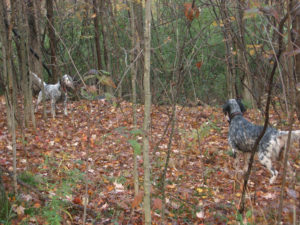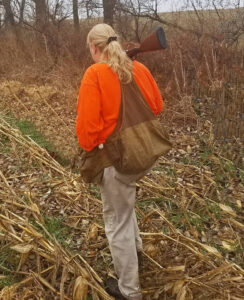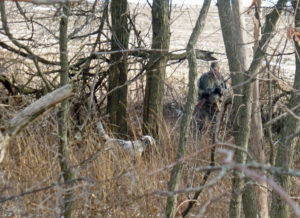Wild Bird Hunting
I am Lynn Dee Galey and I have been passionate about my involvment with bird dogs for 54 years. It started when my Dad handed me a small leather collar and told me to go put it on my favorite pup in the litter he had from the old fashioned Irish Setter that he hunted. Across the years I had dual type Gordon Setters for 25 years and have now had English Setters for about 30 years. When I got my first English Setter I knew that I had found the dogs that were my ideal match in lifestyle and hunting with their natural, no-training-needed field talent and easy, calm disposition.
Since retiring a number years ago I have been fortunate to live a wing-shooters’ lifestyle with my setters. I choose to live where I can put my dogs on wild birds right out my front door so that I can continually develop and assess them. I hunt wild birds 50-60 days a year and travel thousands of miles across the country to hunt but also to selectively breed an occasional litter from my best gun dogs. Vermont is home in my heart and the early 4 generations of Firelight Setters pointed their first grouse and woodcock out the back door of my farmhouse there. Wanderlust then took me to live in Kansas for several years with extended hunting travels to Montana. Quail, sharptail, huns and pheasant expanded my hunting beyond my roots in ruffed grouse and deepened my belief that a good bird dog is one that can do it all. Generations 5 – 8 now prove themselves worthy on a wide variety of species and habitat. The deep, woody smell of the forests is even sweeter after spending time on wind swept prairies though and in 2019, the north woods called me to move to northern Michigan. The dogs and I have settled in a comfortable cottage on the edge of thousands of acres of public land where we can once again roam out the front door and find grouse and woodcock.
In earlier life I showed dogs for almost 30 years and finished numerous champions on the bench. I participated in and judged Hunt Tests and spent many hours in the saddle at my club’s field trials. I ran a training group at my farm in Vermont for many years with a focus on helping owners train their own dogs for hunting and for performance events. This varied history is the reason that I do care about what my bird dogs look like as well as how they perform in the field: I want a classically beautiful setter that is an athlete with strong instincts to handle birds for the gun yet is easy to live with at the end of the day. I strive to own and produce setters who offer all of this and I enjoy meeting the many hunters who feel the same. This type of Setter is in danger of falling victim to it’s beauty and disposition – much like the Irish Setters did in my youth, so I strongly advocate for focusing on the strong, natural hunting instincts and for keeping them out of the pet market. I occasionally offer thoughtfully bred puppies for the serious hunter who wants a companion hunting dog.
My Philosophy: “Quality, not quantity”and “Wild Birds”
I keep a small number of dogs in my kennel and home so that I can give each dog plenty of individual attention and can extensively hunt each one to evaluate their natural abilities before considering them for breeding. It is not acceptable to breed based only the talents of past generations: that is how breed ability becomes diluted and lost. I believe that there is no substitute for lots of wild birds in the development and assessment of a hunting dog: I do not use pen raised birds other than for intro to gun fire. I simply take pups into the woods and the field where there are wild birds and let the birds teach the lessons. All of my photos and videos are the dogs on wild birds; what you see in the photos is what I expect from them and what you can expect from one of my dogs. No ecollars or checkcords are used although I have begrudgingly been dragged into the current century and I do run my dogs with a GPS for safety and when the prairie wind blows louder than my lip whistle (can you say Kansas?!!) I use the tone function to page them.
Training for my dogs is simple everyday obedience as my companions and part of the pack. I am ‘old school’ and do not use ecollars in training or hunting and although I acknowledge that they can be useful tools when used appropriately and kindly. I just personally want dogs that respond and work for me without such devices. I let the birds teach the steadiness lessons and just like the wild birds, I do not tolerate busting or “ripping” birds once a dog is no longer a puppy. I expect my dogs to staunchly hold birds until I arrive and I then flush and shoot and I do not shoot a bird if the dog did not handle it correctly. When hunting, they are expected to handle easily and to know – and care – where I am: we hunt as a team. Don’t misunderstand this to read that the dogs are underfoot in the field, I want them to adjust their range according to where we are hunting. In open country such as in Montana grasslands this means that the dogs will roll 100-400 yards out. But when we hunt in the north woods for ruffed grouse, or thick brush and timber for bobwhite quail in Kansas, the dogs should close in appropriately, typically between 50-100 yards in thick woods. Are they always obedient and handle birds perfectly? Heck no, but then again, their owner and gunner isn’t perfect either but the dogs seem happy with me anyway as I am with them.
I value the relationship I have with my dogs and the only thing I enjoy as much as watching dogs do what comes naturally to them in the field is meeting other people who share the same pleasures. I invite people who are interested in learning more about my dogs specifically to visit and join me for a walk during the off season to see the dogs work and decide if it matches their own preferences. All of the photos on the site have been taken by me while hunting: I usually carry a pocket camera, now my phone, to stop and take photos before walking in to flush the birds, no need to rush. If hunting with other gunners I will also occasionally leave my gun in the truck and carry the DSLR to shoot better photos or video.












